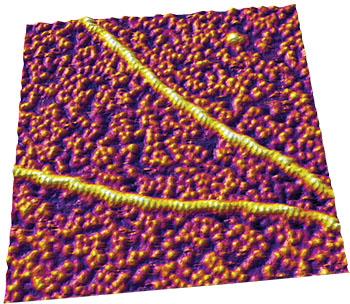AFM Systems
AFM Accessories
Learning
Contact Us

Atomic force microscopy is a powerful tool capable of resolving the structure of molecules under near-physiological conditions. Samples can be imaged in their native state: fully hydrated and at biologically relevant temperatures. No additional sample processing, such as fixation, coating, and dehydration, is required. A key strength of the AFM is its ability to monitor dynamic events. Due to its minimal sample preparation, the interaction between molecules and the response of molecules to external factors can be observed. Another capability is the AFM’s ability to measure the mechanical properties of molecules. Piconewton forces can be detected and intra- and inter-molecular forces can be measured. This allows researchers to increase their understanding of protein dynamics, such as how proteins are assembled and the forces needed to unravel them.
Ask an AFM expert for more information"Multifrequency AFM reveals lipid membrane mechanical properties and the effect of cholesterol in modulating viscoelasticity," Z. Al-Rekabi and S. Contera, Proc. Natl. Acad. Sci. U.S.A. 115, 2658 (2018). https://doi.org/10.1073/pnas.1719065115
"High-resolution AFM structure of DNA G-wires in aqueous solution," K. Bose, C. J. Lech, B. Heddi, and A. T. Phan, Nat. Commun. 9, 1959 (2018). https://doi.org/10.1038/s41467-018-04016-y
"Controlling the mechanoelasticity of model biomembranes with room-temperature ionic liquids," C. Rotella, P. Kumari, B. J. Rodriguez, S. P. Jarvis, and A. Benedetto, Biophys. Rev. 10, 751 (2018). https://doi.org/10.1007/s12551-018-0424-5
"A novel pathway for amyloids self-assembly in aggregates at nanomolar concentration mediated by the interaction with surfaces," S. Banerjee, M. Hashemi, Z. Lv, S. Maity, J. C. Rochet, and Y. L. Lyubchenko, Sci. Rep. 7, 45592 (2017). https://doi/org/10.1038/srep45592
"Endothelial glycocalyx-mediated nitric oxide production in response to selective AFM pulling," A. M. W. Bartosch, R. Mathews, and J. M. Tarbell, Biophys. J. 113, 101 (2017). https://doi.org/10.1016/j.bpj.2017.05.033
"DNA nanostructures-mediated molecular imprinting lithography," C. Tian, H. Kim, W. Sun, Y. Kim, P. Yin, and H. Liu, ACS Nano 11, 227 (2017). https://doi.org/10.1021/acsnano.6b04777
"Self-organized architectures from assorted DNA-framed nanoparticles," W. Liu, J. Halverson, Y. Tian, A. V. Tkachenko, and O. Gang, Nat. Chem. 8, 867 (2016). https://doi.org/10.1038/nchem.2540
"TRF2-mediated control of telomere DNA topology as a mechanism for chromosome-end protection," D. Benarroch-Popivker, S. Pisano, A. Mendez-Bermudez, L. Lototska, P. Kaur, S. Bauwens, N. Djerbi, C. M. Latrick, V. Fraisier, B. Pei, A. Gay, E. Jaune, K. Foucher, J. Cherfils-Vicini, E. Aeby, S. Miron, A. Londoño-Vallejo, J. Ye, M.-H. Le Du, H. Wang, E. Gilson, and M.-J. Giraud-Panis, Mol. Cell 61, 274 (2016). http://dx.doi.org/10.1016/j.molcel.2015.12.009
"Visualizing the path of DNA through proteins using DREEM imaging," D. Wu, P. Kaur, Z. M. Li, K. C. Bradford, H. Wang, and D. A. Erie, Mol. Cell 61, 315 (2016). https://doi.org/10.1016/j.molcel.2015.12.012
"Titin domains progressively unfolded by force are homogenously distributed along the molecule," P. Bianco, Z. Mártonfalvi, K. Naftz, D. Koszegi, and M. Kellermayer, Biophys. J. 109, 340 (2015). https://doi.org/10.1016/j.bpj.2015.06.002
"Direct observation of the reversible two‐state unfolding and refolding of an α/β protein by single‐molecule atomic force microscopy," C. He, C. Hu, X. Hu, X. Hu, A. Xiao, T. T. Perkins, and H. Li, Angew. Chem. Intl. Ed. 54, 9921 (2015). https://doi.org/10.1002/anie.201502938
"Effect of the interaction of the amyloid β (1–42) peptide with short single-stranded synthetic nucleotide sequences: Morphological characterization of the inhibition of fibrils formation and fibrils disassembly," J. N. Abraham, D. Kedracki, E. Prado, C. Gourmel, P. Maroni, and C. Nardin, Biomacromolecules 15, 3253 (2014). https://doi.org/10.1021/bm501004q
"Multiparametric high-resolution imaging of native proteins by force-distance curve–based AFM," M. Pfreundschuh, D. Martinez-Martin, E. Mulvihill, S. Wegmann, and D. J. Muller, Nat. Protoc. 9, 1113 (2014). https://doi.org/10.1038/nprot.2014.070
"The nanomechanical properties of lipid membranes are significantly influenced by the presence of ethanol," F. W. S. Stetter and T. Hugel, Biophys. J. 104, 1049 (2013). https://doi.org/10.1016/j.bpj.2013.01.021
"Non-DLVO adhesion of F-specific RNA bacteriophages to abiotic surfaces: Importance of surface roughness, hydrophobic and electrostatic interactions," C. Dika, M. Ly-Chatain, G. Francius, J. Duval, and C. Gantzer, Colloids Surf. A 435, 178 (2013). https://doi.org/10.1016/j.colsurfa.2013.02.045
"Distinct annular oligomers captured along the assembly and disassembly pathways of transthyretin amyloid protofibrils," R. H. Pires, Á. Karsai, M. J. Saraiva, A. M. Damas, and M. S. Z. Kellermayer, PLoS One 7, e44992 (2012). https://doi.org/10.1371/journal.pone.0044992
"Surface characterization and AFM imaging of mixed fibrinogen–surfactant films," N. Hassan, J. Maldonado-Valderrama, A. P. Gunning, V. J. Morris, and J. M. Ruso, J. Phys. Chem. B 115, 6304 (2011). https://doi.org/10.1021/jp200835j
"Site-specific attachment of proteins onto a 3D DNA tetrahedron through backbone-modified phosphorothioate DNA," N. Y. Wong, C. Zhang, L. H. Tan, and Y. Lu, Small 7, 1427 (2011). https://doi.org/10.1002/smll.201100140
"Tuning the elastic modulus of hydrated collagen fibrils," C. A. Grant, D. J. Brockwell, S. E. Radford, and N. H. Thomson, Biophys. J. 97, 2985 (2009). https://doi.org/10.1016/j.bpj.2009.09.010
"Stepwise dynamics of epitaxially growing single amyloid fibrils," M. S. Z. Kellermayer, A. Karsai, M. Benke, K. Soos, and B. Penke, Proc. Natl. Acad. Sci. U.S.A. 105, 141 (2007). https://doi.org/10.1073/pnas.0704305105
"Packing density and structural heterogeneity of insulin amyloid fibrils measured by AFM nanoindentation," S. Guo, and B. B. Akhremitchev, Biomacromolecules 7, 1630 (2006). https://doi.org/10.1021/bm0600724
"Temperature softening of a protein in single-molecule experiments," M. Schlierf and M. Rief, J. Mol. Biol. 354, 497 (2005). https://doi.org/10.1016/j.jmb.2005.09.070
"Reversible mechanical unzipping of amyloid β-fibrils," M. S. Z. Kellermayer, L. Grama, Á. Karsai, A. Nagy, A. Kahn, Z. L. Datki, and B. Penke, J. Biol. Chem. 280, 8464 (2004). https://doi.org/10.1074/jbc.m411556200
"Segmented nanofibers of spider dragline silk: Atomic force microscopy and single-molecule force spectroscopy," E. Oroudjev, J. Soares, S. Arcidiacono, J. B. Thompson, S. A. Fossey, and H. G. Hansma, Proc. Natl. Acad. Sci. U.S.A. 99, 6460 (2002). https://doi.org/10.1073/pnas.082526499
"Can non-mechanical proteins withstand force? Stretching barnase by atomic force microscopy and molecular dynamics simulation," R. B. Best, B. Li, A. Steward, V. Daggett, and J. Clarke, Biophys. J. 81, 2344 (2001). https://doi.org/10.1016/s0006-3495(01)75881-x